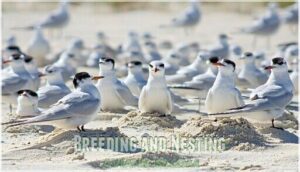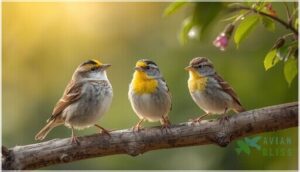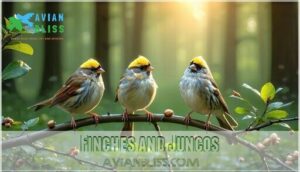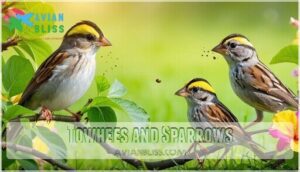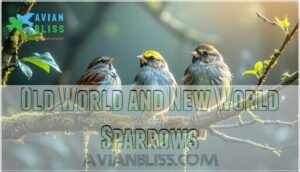This site is supported by our readers. We may earn a commission, at no cost to you, if you purchase through links.
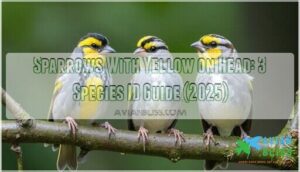
Yellow-throated Sparrows, despite their name, actually display golden throat markings rather than head coloration.
These distinctive markings help you distinguish them from dozens of other brown sparrows that frequent your backyard.
Golden-crowned Sparrows migrate along the Pacific Coast, White-throated Sparrows prefer eastern woodlands, and each species has unique songs that’ll become your secret weapon for identification even before you spot their colorful crowns.
Table Of Contents
- Key Takeaways
- Sparrows With Yellow Heads
- Identifying Yellow Headed Sparrows
- Habitat and Behavior
- Diet and Feeding Habits
- Breeding and Nesting
- Conservation Status
- Similar Species Comparison
- Frequently Asked Questions (FAQs)
- Are Golden-crowned Sparrows rare?
- What does a golden-crowned sparrow eat?
- What kind of birds have yellow heads?
- What is the difference between golden-crowned and white crowned sparrows?
- Do sparrows with yellow heads mate for life?
- What time of day are yellow-headed sparrows most active?
- How long do yellow-crowned sparrows typically live?
- Can you attract yellow-headed sparrows with specific plants?
- Conclusion
Key Takeaways
- You’ll identify three main species by their yellow markings: Golden-crowned Sparrows have bright yellow crowns with black borders, White-throated Sparrows show yellow patches between their eyes and bills, and Yellow-throated Sparrows display golden throat patches.
- You can distinguish these birds from similar species by location and habitat—Golden-crowned Sparrows migrate along the Pacific Coast, White-throated Sparrows prefer eastern woodlands, while Yellow-throated Sparrows are actually Asian weavers, not true North American sparrows.
- You’ll attract these birds to your yard with proper feeder placement near shrubs, offering sunflower seeds and millet, plus providing water sources, since they prefer feeding areas with quick escape routes to dense cover.
- You can use their unique songs as identification tools even before spotting them—Golden-crowned Sparrows sing descending "oh-dear-me" whistles, while White-throated Sparrows deliver sweet "Old-Sam-Peabody" calls that’ll help you locate them in dense vegetation.
Sparrows With Yellow Heads
You’ll encounter three distinct sparrow species that display yellow markings on their heads across North America.
These bright yellow patches serve as key identification features that separate them from the dozens of other "little brown jobs" in the sparrow family, which is a distinct aspect of their appearance.
Golden-crowned Sparrow
You’ll recognize the Golden-crowned Sparrow by its distinctive bright yellow crown bordered by black stripes on its head plumage.
You’ll spot this distinctive crown pattern from quite a distance, making field identification surprisingly straightforward.
Crown size actually indicates dominance in males, reducing conflicts during breeding season.
These sparrows with yellow head markings show yellow or yellow-orange beak color in immatures.
During feather molting periods, the yellow headed sparrow’s crown may appear less vibrant, making bird species identification challenging among types of sparrows.
Understanding their arctic migration patterns can also provide valuable insights into their behavior and habitat preferences.
White-throated Sparrow
Looking beyond the crown of this species, you’ll spot yellow between the eye and bill on the lores.
The whitethroated sparrow’s distinctive head patterns make sparrow identification easier than many relatives.
Key identification features include:
- Beak Color: Dark upper mandible with lighter lower section
- Wing Bars: Two prominent white bars across dark wings
- Feather Texture: Crisp white throat patch contrasts sharply with gray breast
Unlike the whitecrowned sparrow, this yellow headed sparrow shows more subdued coloring overall.
Yellow-throated Sparrow
Yellow-throated Sparrows aren’t actually true sparrows but belong to the weaver family from southern Asia.
You’ll spot males displaying a distinctive pale yellow throat patch that catches sunlight like a tiny beacon.
These tree-loving birds prefer perching on bare branches, making identification easier than ground-dwelling Yellowheaded Sparrows.
| Feature | Description | Identification Tip |
|---|---|---|
| Throat Patch | Pale yellow, prominent in males | Most visible during breeding season |
| Habitat | Trees, wires, open ground | Unlike marsh-dwelling species |
| Behavior | Perches openly on branches | Less secretive than native sparrows |
| Range | Southern Asia (introduced species) | Not found on Migration Routes |
Identifying Yellow Headed Sparrows
You’ll find that identifying yellow-headed sparrows requires careful attention to the specific placement and intensity of yellow coloring on each species.
The Golden-crowned Sparrow displays a bright yellow crown stripe, while the White-throated Sparrow shows yellow patches between the eye and bill, making precise observation of head markings your most reliable identification tool, which involves careful attention to the specific placement.
Distinctive Head Markings
When identifying yellow headed sparrows, you’ll spot distinct Head Patterns that separate each species.
Golden-crowned Sparrows display bright yellow Crown Colors with bold black stripes, while White-throated Sparrows show yellow between eye and bill.
These Facial Marks, combined with specific Beak Shapes and Feather Textures, help distinguish yellow feathered birds from similar Song Sparrow relatives in the field.
Observing the head stripe patterns is essential for accurate identification of these species.
Migration Patterns
Tracking these yellow headed sparrows reveals distinct seasonal movements across North America’s major flyway routes.
Each species follows different migration timing, with some traveling thousands of miles to reach wintering grounds while others remain year-round residents.
- Golden-crowned Sparrows: Breed in Alaska/western Canada, winter along Pacific Coast from British Columbia to Baja California
- White-throated Sparrows: Migrate from Canadian boreal forests to southeastern US, using major stopover sites along the way
- Yellow-throated Sparrows: Remain primarily in southern Asia year-round, showing minimal seasonal movements compared to North American species
Unique Songs
Listen carefully to decipher each species’ unique vocal fingerprint.
Golden-crowned Sparrows deliver clear, descending whistles that sound like "oh-dear-me," while White-throated Sparrows offer sweet, high whistles resembling "Old-Sam-Peabody."
Song Sparrows showcase complex song patterns with varied melody types and harmonic structure.
These distinctive bird calls help separate yellow-headed species from similar birds like yellow headed finch or Yelloweyed Junco through vocal learning differences.
Habitat and Behavior
You’ll find these yellow-headed sparrows in surprisingly diverse environments, from dense thickets to your own backyard.
Each species has distinct habitat preferences that make identification easier once you know where to look, and understanding these preferences is key to recognizing the diverse environments they inhabit.
Open and Shrubby Areas
You’ll discover these yellow-headed sparrows thriving in diverse Shrub Landscapes and Open Woodlands across North America.
These Sparrow Habitats offer perfect conditions where Brush Areas meet open spaces, creating ideal Edge Effects.
Observing these birds often requires proper bird watching gear.
Here’s where you’ll spot them:
- Golden-crowned Sparrow – Dense chaparral and forest edges with thick understory
- Song Sparrow – Weedy fields bordering shrubland with scattered perches
- Chipping Sparrow – Backyard shrubs near open lawn areas
Wet Areas and Marshes
You’ll find these yellow-headed sparrows thriving where water meets land, making wetlands their perfect hunting grounds.
Marsh Habitat supports diverse species, with Song Sparrows dominating cattail edges while Savannah Sparrows prefer drier marsh borders.
| Species | Preferred Water Levels | Aquatic Plants Used |
|---|---|---|
| Song Sparrow | Shallow to moderate | Cattails, sedges |
| Savannah Sparrow | Seasonal flooding | Grasses, rushes |
| Swamp Sparrow | Deep water edges | Tall reeds, bulrush |
| Yellow-headed Blackbird | Open water areas | Emergent vegetation |
Shoreline Ecology creates ideal nesting spots where Wetland Birds can access both insects and seeds year-round.
Backyard Feeders
You’ll attract yellow-headed sparrows like Golden-crowned and White-throated species to your yard with proper feeder placement and seed selection.
These backyard birds prefer different feeding habits than yellow headed blackbird or House Sparrow:
- Position bird feeders near shrubs for quick escape routes
- Offer sunflower seeds and millet in tube or platform feeders
- Add bird baths nearby since yellow birds need water sources
Smart yard layout combines feeding stations with natural cover, considering effective bird feeder placement to attract various species, and looking into bird feeding options for the best results, which includes creating a proper feeder placement and using the right seed selection to make your yard attractive to these birds, ultimately leading to a successful yard layout.
Diet and Feeding Habits
You’ll find these yellow-headed sparrows have surprisingly varied diets that change with the seasons.
Nature’s feathered friends switch from winter seeds to breeding season bugs with remarkable dietary flexibility.
They primarily eat seeds and plant material during winter months, then switch to insects and spiders when breeding season arrives.
Seeds and Insects
The primary dietary needs of these yellow-headed sparrows revolve around protein-rich insects during breeding season and energy-dense seeds throughout winter months.
You’ll observe their forage strategies shifting seasonally—Golden-crowned Sparrows scratch through leaf litter for beetles, while White-throated Sparrows employ ground-dwelling insect foraging techniques.
Their seed preferences include sunflower seeds and native grasses, with feeding habits adapting to available resources unlike the yellow headed blackbird’s different approach, focusing on energy-dense seeds and utilizing ground-dwelling insect foraging.
Fruits and Berries
Yellow-headed sparrows enthusiastically embrace nature’s candy throughout the year. Fruit Consumption peaks during late summer when wild elderberries and serviceberries ripen, providing essential energy for migration.
These Berry Preferences showcase their dietary flexibility:
- Wild elderberries for antioxidants
- Mountain ash berries in northern regions
- Cultivated blueberries at backyard feeders
- Dried berries during harsh winters
Song Sparrow populations thrive where berry-producing shrubs flourish, using Foraging Strategies like hover-feeding to extract delicate fruit while supporting vital Seed Dispersal across habitats.
Understanding qualitative data analysis helps researchers uncover patterns in bird behavior and preferences.
Foraging on Ground
While your yellow-headed sparrows scratch through leaf litter, they’re demonstrating remarkable ground foraging strategies that separate casual seed-eating from serious insect hunting.
These ground-nesting specialists use their feet to kick backward, exposing hidden treasures beneath vegetation where feeding behaviors reveal their adaptability. The use of effective ground bird feeders can substantially enhance the observation of these behaviors.
| Species | Ground Foraging Style | Primary Targets |
|---|---|---|
| Golden-crowned Sparrow | Scratches through leaves | Seeds, berries, insects |
| White-throated Sparrow | Double-scratch technique | Sunflower seeds, millet |
| Yellow-throated Sparrow | Ground and bush combo | Seeds, grains, small insects |
| Song Sparrow | Active ground search | Beetles, caterpillars, seeds |
| Swamp Sparrow | Near-water foraging | Plant matter, aquatic insects |
The observation of these groundnesting specialists and their foraging behaviors can be enhanced with the right equipment and understanding of their primary targets, making for a more engaging and educational experience.
Breeding and Nesting
You’ll find these yellow-headed sparrows have fascinating breeding habits that vary by species and location.
Their nesting strategies range from ground-level construction to elevated shrub placement, with timing that follows distinct seasonal patterns.
Nest Construction
When you’re observing nesting birds, you’ll discover female sparrows craft their cup-shaped homes using grass, twigs, and moss.
These master architects weave soft materials like hair or feathers into nest architecture that’s both sturdy and cozy.
Sparrows strategically select nest placement locations from ground level to low shrubs, ensuring their bird nests remain hidden within dense vegetation for ideal protection during the critical nest building process.
Some species even recycle spider silk for strength in their nests.
Egg-laying and Incubation
Once you’ve found their nest materials, you’ll discover clutch size typically ranges from 4-6 eggs with distinctive egg coloration patterns.
Incubation length spans approximately 12-14 days, during which parental care becomes critical.
The female handles most incubation duties while males provide protection, and bird breeding patterns show these yellow-headed species maintain consistent nesting habits, with bird nests requiring steady temperatures for successful hatching across all three species.
Fledging Periods
After their wings develop strength, these sparrows make their nest departure around 9-12 days old.
You’ll notice fledgling care continues as parents feed their young for another week.
Wing development varies among bird species – Song Sparrow and American Tree Sparrow fledglings can’t fly well initially.
Brood size affects nest success rates, with smaller clutches often showing better survival outcomes.
Conservation Status
You’ll find that sparrows with yellow head markings generally face fewer conservation challenges than many other bird species.
The Golden-crowned and White-throated Sparrows maintain stable populations, while the Yellow-throated Sparrow from Asia shows resilience across its range.
Endangered and Near Threatened
Several sparrow species with yellow head markings face serious conservation challenges.
Baird’s Sparrow has lost over 50% of its population in fifty years due to habitat loss from agricultural expansion.
Saltmarsh Sparrow populations declined similarly, threatened by sea level rise affecting tidal marshes.
Bachman’s Sparrow earned Red Alert status from pine forest destruction.
These endangered species require immediate conservation efforts and population monitoring to prevent further species decline in threatened habitats.
Population Trends
Most bird species face challenging times, but these three sparrows show different population trends.
Golden-crowned Sparrows experience modest declines in the Pacific Northwest, while Christmas Bird Count data reveals gradual decreases in California wintering areas.
White-throated Sparrows suffered a concerning 31% population decline over fifty years due to habitat loss.
Yellow-throated Sparrows buck the trend with stable numbers in South Asia, adapting well to agricultural landscapes and urban gardens despite conservation efforts addressing species decline.
Understanding migratory bird conservation is essential for developing effective strategies to protect these species.
Threats and Protection
You’ll face habitat loss and climate change as primary threats to these yellow-headed sparrows.
Human impact through development destroys critical sparrow habitats, while predator control becomes essential near urban areas.
Conservation efforts focus on habitat conservation and bird protection programs.
Bird conservation groups work tirelessly protecting nesting sites and migration corridors, ensuring these feathered friends don’t disappear from your local landscapes.
Similar Species Comparison
You might confuse yellow-headed sparrows with other small birds that share similar coloring patterns.
House sparrows lack the distinctive yellow markings, while finches typically show brighter yellow and different body proportions than true sparrows.
Finches and Juncos
You’ll quickly notice that finches and juncos share similar Seed Preferences but differ dramatically in Feather Colors and Beak Shapes.
While American Tree Sparrow sports rusty caps, finches show conical bills perfect for cracking seeds.
Junco Behavior includes ground-hopping unlike typical Finch Migration patterns.
| Feature | Finches | Juncos |
|---|---|---|
| Bill Shape | Conical, thick | Pointed, slender |
| Ground Foraging | Occasional | Primary method |
| Flock Behavior | Small groups | Large winter flocks |
| Tail Markings | Variable | White outer feathers |
Towhees and Sparrows
You’ll notice towhees share the sparrow family tree but sport larger bodies and longer tails.
While Song Sparrow and Chipping Sparrow stick to delicate seed-cracking, towhees use stronger beaks for ground-scratching adventures.
| Feature | Sparrows | Towhees |
|---|---|---|
| Beak Shapes | Thin, pointed for seeds | Robust, thick for scratching |
| Plumage Colors | Subtle browns, grays | Bold rufous, black patterns |
| Feather Patterns | Streaked, mottled | Clean blocks of color |
| Sparrow Migration | Many migrate seasonally | Mostly year-round residents |
| Towhee Behavior | Hop delicately on branches | Scratch vigorously in leaf litter |
Old World and New World Sparrows
Understanding the differences between Old World and New World Sparrows helps you appreciate why certain species show distinctive yellow markings.
New World Sparrows like Song Sparrow, Goldencrowned Sparrow, American Tree Sparrow, and Whitecrowned Sparrow evolved separately from their Old World cousins over 20 million years ago.
| Feature | Old World Sparrows | New World Sparrows |
|---|---|---|
| Feather Colors | Rarely yellow head markings | Yellow on Golden-crowned, White-throated |
| Wing Patterns | Simpler designs | Complex Plumage Texture variations |
| Sparrow Migration | Less migratory | Extensive seasonal movements |
New World species developed brighter Beak Shapes and more melodious songs during their American evolution.
Frequently Asked Questions (FAQs)
Are Golden-crowned Sparrows rare?
Golden-crowned Sparrows aren’t rare – they’re listed as Least Concern with stable populations.
You’ll find them breeding in western mountains and wintering along the Pacific coast in brushy areas.
Understanding rare bird species can help identify conservation priorities for various bird populations.
What does a golden-crowned sparrow eat?
You’ll find golden-crowned sparrows foraging mainly on the ground, eating seeds, berries, buds, and insects.
Their diet shifts seasonally—they prefer seeds and plant material during winter months, while insects and spiders become more important for summer nutrition.
What kind of birds have yellow heads?
Roughly 30% of North American songbirds sport some yellow plumage.
You’ll spot yellow-headed birds like American Goldfinches, Yellow Warblers, Evening Grosbeaks, and Golden-crowned Sparrows across diverse habitats from backyards to wilderness areas.
What is the difference between golden-crowned and white crowned sparrows?
You’ll spot the key difference in their crowns: golden-crowned sparrows display bright yellow bordered by black stripes, while white-crowned sparrows show bold black-and-white striped heads without yellow coloring.
Do sparrows with yellow heads mate for life?
Notably, you’re asking about monogamy in birds that don’t actually practice it.
Sparrows with yellow crowns, like Golden-crowned and White-crowned species, don’t mate for life—they’re seasonally monogamous, choosing new partners each breeding season.
What time of day are yellow-headed sparrows most active?
Yellow-headed sparrows are most active during early morning and late afternoon hours.
You’ll spot them foraging busily at dawn and dusk when temperatures are cooler and insect activity peaks, making these prime feeding times.
How long do yellow-crowned sparrows typically live?
Golden-crowned sparrows typically live 3-7 years in the wild, though you’ll find some exceptional individuals reaching 10+ years.
Their lifespan depends on avoiding predators like hawks and cats while traversing seasonal migrations successfully.
Can you attract yellow-headed sparrows with specific plants?
Looking to create a bird paradise in your backyard?
You’ll attract Golden-crowned and White-throated Sparrows by planting native shrubs like elderberry, dogwood, and serviceberry that produce seeds and berries they crave year-round.
Conclusion
Spotting sparrows with yellow on head is like deciphering a secret code in your backyard.
You’ve learned the taxonomic traits and behaviors that set Golden-crowned, White-throated, and Yellow-throated Sparrows apart.
Next time a little brown bird hops by, you’ll know what to look for—yellow patches, migration habits, and unique songs.
With these ID tips, you won’t mistake a finch for a sparrow.
Keep your binoculars ready; your local birdlife just got a lot more interesting.
- https://www.birdweb.org/birdweb/bird/golden-crowned_sparrow
- https://www.reddit.com/r/whatsthisbird/comments/y5jwbk/can_anyone_help_with_this_sparrow_the_center_line/
- https://en.wikipedia.org/wiki/Yellow-throated_sparrow
- https://scvbirdalliance.org/backyard-bird-blog/white-crowned-and-golden-crowned-sparrows
- https://www.pa.gov/agencies/pgc/wildlife/discover-pa-wildlife/finches-and-house-sparrow.html






